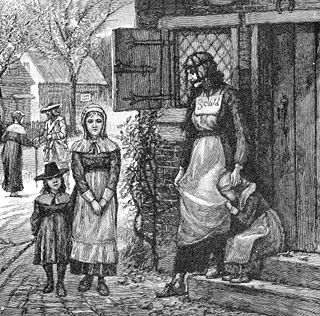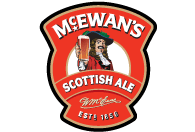

A drunkard's cloak was a type of pillory used in various jurisdictions to punish miscreants.


A drunkard's cloak was a type of pillory used in various jurisdictions to punish miscreants.
The drunkard's cloak was actually a barrel, into the top of which a hole was made for the head to pass through. Two smaller holes in the sides were cut for the arms. Once suitably attired, the miscreant was paraded through the town, effectively pilloried. [1]
Drunkenness was first made a civil offence in England by the Ale Houses Act 1551, or "An Act for Keepers of Ale-houses to be bound by Recognisances". [nb 1] According to Ian Hornsey, the drunkard's cloak, sometimes called the "Newcastle cloak", [3] became a common method of punishing recidivists, [1] especially during the Commonwealth of England. From 1655 Oliver Cromwell suppressed many of England's alehouses, particularly in Royalist areas, and the authorities made regular use of the cloak. [4]
An early description of the drunkard's cloak appears in Ralph Gardiner's England's Grievance Discovered, first published in 1655. [5] A John Willis claimed to have travelled to Newcastle and seen
men drove up and down the streets, with a great tub, or barrel, opened in the sides, with a hole in one end, to put through their heads, and to cover their shoulders and bodies, down to the small of their legs, and then close the same, called the new fashioned cloak, and so make them march to the view of all beholders; and this is their punishment for drunkards, or the like. [6]
Gardiner's account was reproduced in 1789 in John Brand's History of Newcastle-on-Tyne, accompanied by an early illustration of a drunkard's cloak. A similar device was used in Holland; William Brereton noted its use in Delft in 1634, as did Samuel Pepys at The Hague in 1660. [7] One author also recorded its existence in 1784 in Denmark, where it was called the "Spanish Mantle". [8] These occurrences, along with the observations of one 19th-century historian, who noted that no mention of the punishment was made in any local documentation, including the Newcastle Corporation accounts, prompted William Andrews to suppose in 1899 that the Drunkard's Cloak was a custom imported from the Continent, and that its use in England was confined to Newcastle. [7]
Further afield, instances of its use are found in the US; a paper described in 1862 how a "wretched delinquent was gratuitously framed in oak, his head being thrust through a hole cut in one end of a barrel, the other end of which had been removed, and the poor fellow loafed about in the most disconsolate manner, looking for all the world like a half-hatched chicken." [9]

The pillory is a device made of a wooden or metal framework erected on a post, with holes for securing the head and hands, formerly used for punishment by public humiliation and often further physical abuse. The pillory is related to the stocks.

Stocks are feet restraining devices that were used as a form of corporal punishment and public humiliation. The use of stocks is seen as early as Ancient Greece, where they are described as being in use in Solon's law code. The law describing its use is cited by the orator Lysias: "'He shall have his foot confined in the stocks for five days, if the court shall make such addition to the sentence.' The 'stocks' there mentioned, Theomnestus, are what we now call 'confinement in the wood'".

A scold's bridle, sometimes called a witch's bridle, a gossip's bridle, a brank's bridle, or simply branks, was an instrument of punishment, as a form of public humiliation. It was an iron muzzle in an iron framework that enclosed the head. A bridle-bit, about 5 cm × 2.5 cm in size, was slid into the mouth and pressed down on top of the tongue, often with a spike on the tongue, as a compress. It functioned to silence the wearer from speaking entirely, and caused extreme pain and physiological trauma to scare and intimidate the wearer into submission. The scold's bridle was used on women. This prevented speaking and resulted in many unpleasant side effects for the wearer, including excessive salivation and fatigue in the mouth. For extra humiliation, a bell could also be attached to draw in crowds. The wearer was then led around town by a leash.

In the common law of crime in England and Wales, a common scold was a type of public nuisance—a troublesome and angry person who broke the public peace by habitually chastising, arguing, and quarrelling with their neighbours. Most punished for scolding were women, though men could be found to be scolds.

Ducking stools or cucking stools were chairs formerly used for punishment of disorderly women, scolds, and dishonest tradesmen in medieval Europe and elsewhere at later times. The cucking-stool was a form of wymen pine, or "women's punishment", as referred to in Langland's Piers Plowman (1378). They were instruments of public humiliation and censure both primarily for the offense of scolding or backbiting and less often for sexual offences like bearing an illegitimate child or prostitution.

McEwan's is a brand of beer owned by Carlsberg Marston's Brewing Company. It was originally brewed by William McEwan's Fountain Brewery in Edinburgh, Scotland. The McEwan's brand passed to Heineken in 2008 after their purchase of Scottish & Newcastle's British operations. Heineken sold the brand to Wells & Young's in 2011, who sold their brewing operation, including the McEwan brand to Marston's in 2017. Cans and bottles are now brewed in Bedford, England.
Webster's Brewery was a brewery that was founded in 1838 by Samuel Webster and operated at the Fountain Head Brewery in Halifax, West Riding of Yorkshire, England. Webster's Green Label, a light mild, and Yorkshire Bitter gained national distribution after the company was taken over by Watney Mann in 1972. Throughout the 1970s it was known for the advertising slogan: "Drives out the northern thirst".

Human branding or stigmatizing is the process by which a mark, usually a symbol or ornamental pattern, is burned into the skin of a living person, with the intention that the resulting scar makes it permanent. This is performed using a hot or very cold branding iron. It therefore uses the physical techniques of livestock branding on a human, either with consent as a form of body modification; or under coercion, as a punishment or to identify an enslaved, oppressed, or otherwise controlled person. It may also be practiced as a "rite of passage", e.g. within a tribe, or to signify membership of or acceptance into an organization.

Bilboes are iron restraints normally placed on a person's ankles. They have commonly been used as leg shackles to restrain prisoners for different purposes until the modern ages. Bilboes were also used on slave ships, such as the Henrietta Marie. According to legend, the device was invented in Bilbao and was imported into England by the ships of the Spanish Armada for use on prospective English prisoners. However, the Oxford English Dictionary notes that the term was used in English well before then.

Alice Morse Earle was an American historian and writer from Worcester, Massachusetts.
England under Elizabeth I's reign, the Elizabethan Era, was ruled by the very structured and complicated Elizabethan government. It was divided into the national bodies, the regional bodies, the county, community bodies and the court system.

Elizabeth Needham, also known as Mother Needham, was an English procuress and brothel-keeper of 18th-century London, who has been identified as the bawd greeting Moll Hackabout in the first plate of William Hogarth's series of satirical etchings, A Harlot's Progress. Although Needham was notorious in London at the time, little is recorded of her life, and no genuine portraits of her survive. Her house was the most exclusive in London and her customers came from the highest strata of fashionable society, but she eventually ran afoul of the moral reformers of the day and died as a result of the severe treatment she received after being sentenced to stand in the pillory.
Truman's Brewery was a large East London brewery and one of the largest brewers in the world at the end of the 19th century. Founded around 1666, the Black Eagle Brewery was established on a plot of land next to what is now Brick Lane in London, E1. It grew steadily until the 18th century when, under the management of Benjamin Truman, and driven by the demand for porter, it expanded rapidly and became one of the largest brewers in London. Its growth continued into and through the 19th century with the expansion of its brewery and pub estate. In 1873, it purchased Philips Brewery in Burton and became the largest brewery in the world.

Camerons Brewery is an English brewery established by John William Cameron in Stranton, Hartlepool, County Durham, in 1865. It is the largest independent brewer in the North East of England, with a brewery capacity of 1.5 million hectolitres and a tied estate of 75 houses. It is one of the oldest industrial concerns in Hartlepool, and has historically been one of the largest employers.

The bankruptcy barrel is a visual symbol, primarily of the 20th century, used in cartoons and other media as a token of destitution. Not intended to be realistic, it consists of a suit made of only a wooden barrel held on by suspenders, indicating that the subject is so poor that he is unable to afford even clothes. It was a common representation of bankruptcy, appearing in many animated shorts, political cartoons, comedies, and other media.

The Relief of the Poor Act 1696, formally titled An Act for supplying some Defects in the Laws for the Relief of the Poor of this Kingdom, was a 1697 welfare statute, operating within the framework of the Poor Relief Act 1601. This act is perhaps best remembered for its expansion of the requirement that welfare recipients be marked to indicate their status, in this case by wearing a prominent badge.

Old Doctor Butler's Head is a pub in Mason's Avenue, London EC2. The pub was named after the physician William Butler, a doctor at the court of James I. Butler is credited with inventing the medicinal drink Dr Butler’s purging ale, which became popular in 17th-century England.

Norman Shanks Kerr was a Scottish physician and social reformer who is remembered for his work in the British temperance movement. He originated the Total Abstinence Society and was founder and first president of the Society for the Study and Cure of Inebriety which was founded in 1884.
Sir William Rawlinson (1640–1703) was an English serjeant-at-law and Commissioner for the Great Seal of the Realm between 1688 and 1693.
Unlike neighboring England and Scotland, there were few witchcraft accusations and trials in Wales throughout the 1500s to mid-1700s, and most of the accused were acquitted. Only five people were executed in Wales for witchcraft during this period.